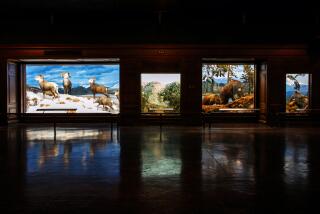Rain Forest Travels to San Diego
- Share via
SAN DIEGO — A blue and gold macaw on loan from the San Diego Zoo for a few hours crunched sunflower seeds while perching on its trainer’s arm and whistling on cue for visitors.
Outside, the weather couldn’t have been better for the occasion: tropical, hot and sunny.
Inside, it was the same.
But for officials of San Diego Museum of Natural History, the conditions lent an air of reality to their showing off “Tropical Rainforests: A Disappearing Treasure,” the museum’s newest exhibit.
The 6,000-square-foot traveling show, produced by the Smithsonian Institution, will be the largest exhibition ever featured in the 116-year history of the San Diego museum when it opens to the public Sunday for a run through Sept. 23.
“It is beautiful,” proclaimed Pam Bruder, president of the museum’s board of trustees, during a sneak preview Thursday.
The world’s rapidly disappearing rain forests sit in a band 20 degrees north and south of the Equator. The Amazon in South America, while the best known, is only one of the rain forests found in Central America, Southeast Asia, Madagascar and other parts of the world, said Bruder.
The Smithsonian’s show “brings attention to habitat destruction on a global basis,” she said.
Glowing with pride (and from the heat wave), Payne Johnson, the museum’s development director, said getting the installation was almost a fluke.
The show, which premiered to huge crowds in Washington, D.C., in 1988, was not scheduled to visit San Diego until 1992. But in March of this year, “We got a call that the Missouri Botanical Garden had dropped out,” Johnson said. The opening represented a narrow window of opportunity for San Diego, and the museum’s trustees decided to jump at it.
The timing couldn’t be better, he said. This year marks the 20th anniversary of Earth Day and the rapid destruction of the rain forests is high in the news.
“We felt it was important to have it here,” he said. “San Diego is on the border of the Latin world, where a majority of the endangered rain forests are located, and the problems are of particular interest and concern to us here.”
The museum still needs to raise about $30,000 to pay for the $75,000 installation, but trustees are hoping donors will make up the difference once they see the exhibition.
One of the highlights of the exhibition, which wraps through much of the museum’s second floor, is a stunning 12-minute slide show coordinated on 19 projectors.
The show opens with a tropical dawn breaking across five screens that reach nearly from floor to ceiling. Frogs, birds, bats, butterflies, and fungi that glow in the dark flash across a green, 20-foot-wide segment of a Malaysian rain forest.
Elsewhere, an American living room is fully furnished with products from the jungle. The room is detailed right down to the parquet floors and the jungle films playing on the television set.
But interlaced with the exhibition’s gentle assault on the sight and senses is a not-so-gentle message that the 2.5 billion acres of remaining forests are rapidly disappearing.
“Every minute approximately 54 acres of tropical forest, the size of 10 city blocks, are destroyed,” said Hal Mahan, the museum’s executive director. “At this rate, in less than 100 years the rain forests will be gone.”
The exhibition presents no easy solutions to the destruction of the rain forests, however. A computer game at the end of the tour drives home the problem of deciding even if a road should go through the forest to connect a capital city with a river settlement. At odds are the needs of the wilderness, the Indian inhabitants, city dwellers, the river settlement and the frontier town.
The game shows visitors firsthand the impact of their decision, both long-term and short-term.
The museum is located in Balboa Park at Park Boulevard and Village Place. Admission is $5 for adults, $1 for students 6-18 years old and free for children 5 years and younger. Summer hours are 10 a.m.-5 p.m. For further information, call 232-3921.
More to Read
Sign up for The Wild
We’ll help you find the best places to hike, bike and run, as well as the perfect silent spots for meditation and yoga.
You may occasionally receive promotional content from the Los Angeles Times.




